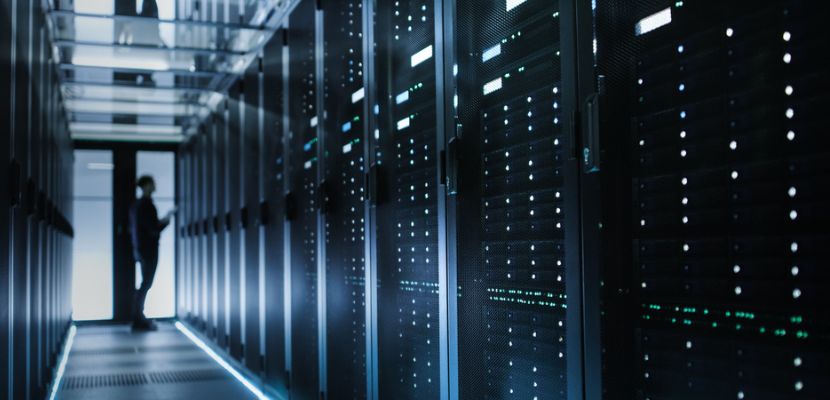Bare metal servers are dedicated servers that offer unparalleled performance, control, and security. Raw processing power, the absence of hypervisor overhead, and dedicated resources are just some of the benefits that bare metal servers offer to users.
This article explains everything you need to know about bare metal servers and their benefits and explains how to best set up and manage them.

What Is a Bare Metal Server?
A bare metal server is a physical server dedicated entirely to a single user. It allows direct access to the server’s hardware without any virtualization. This gives the user full control over every aspect of the infrastructure, including the choice of operating system, hardware configurations, and applications.
By avoiding virtualization and hypervisor overhead, a bare metal server provides superior performance that comes with all the processing power and memory allocated to a single tenant. The isolation inherent in bare metal servers means that users avoid the “noisy neighbor” problem, enjoying enhanced security and stability. These features make metal servers ideal for high-performance computing, large databases, or gaming servers.
Know your options and choose a server hosting solution tailored to your needs. Discover the differences between bare metal and VM servers or find out how bare metal compares to dedicated servers.
Bare Metal Server Structure
A traditional bare metal server consists of just two layers: the physical hardware and the software. The server hardware, such as the central processing unit (CPU), memory (RAM), storage drives (SSDs or HDDs), and network connections, is housed in a specialized data center that oversees security and ensures optimal performance and reliability.
Unlike virtual environments, where hardware is abstracted and distributed among several virtual machines (VMs), a bare metal server allocates all resources to a single tenant. The user chooses an operating system and configurations that align with the specific needs of application deployment and performance.
This simple structure and the absence of an intervening hypervisor layer make bare metal servers exceptionally powerful and efficient.
Bare metal servers can also come with a thin layer of virtualization. These hypervisor-based bare metal servers, or Type-1 hypervisors, still provide direct access to physical hardware but add a layer of abstraction for improved management of computing resources. A bare metal hypervisor is installed directly on the server’s hardware and runs multiple virtual machines with their own operating systems. This allows multiple isolated environments to function independently on the same server, ensuring performance, security, and stability.
Bare Metal Server Initial Setup
The initial setup of a bare metal server includes several crucial steps:
- Hardware selection and configuration. Choosing the appropriate hardware involves determining the necessary CPU power, RAM, storage capacity, networking capabilities, and other elements that contribute to the successful development and deployment of applications.
- Physical setup. After selecting the hardware, it is necessary to install it in a server room or data center. This includes ensuring adequate power supply, cooling systems, and physical security, as well as providing bandwidth for connectivity.
- Operating system installation. The user selects an operating system based on their business needs. The OS is installed directly on the server’s hardware.
- Configuration and optimization. After installing the operating system, the user configures the server by setting up user accounts, deploying security protocols, and installing software and applications. During this step, it is necessary to ensure that the network configurations provide maximum efficiency and performance.
- Maintenance and monitoring. Continuous maintenance and monitoring ensure that the operating system and applications are up to date, and all security protocols are in place. Regularly checking the state of the physical servers ensures that all components are functioning correctly.
Benefits of Using a Bare Metal Server
Bare metal servers offer various benefits, including:
- Optimized performance. Without the hypervisor layer, bare metal servers allow direct access to resources without interruption, even for resource-intensive tasks.
- Dedicated resources. In a bare metal server environment, all resources are dedicated to a single user.
- Enhanced security and reliability. The physical isolation of the bare metal server ensures data is segregated and safe from breaches or other cyber threats.
- Customization and control. Users have full control over the configuration of a bare metal server, including choosing the operating system, hardware specifications, and other system details.
- Reduced overhead. Without the overhead of virtualization, bare metal servers operate more efficiently, granting users unparalleled performance.
- Predictable costs. Bare metal servers come with predictable pricing models and fixed costs that do not fluctuate based on usage.
- Compliance. For organizations operating in highly regulated industries, bare metal servers make it easier to achieve the level of data protection necessary for compliance.
Who Should Use a Bare Metal Server?
Bare metal servers are suitable for many types of users and organizations, including:
- Large enterprises with resource-intensive applications.
- High-traffic websites and ecommerce platforms.
- Gaming companies hosting multiplayer games.
- Organizations with stringent security requirements.
- IT and cloud service providers.
- Companies with stable, predictable workloads.
- Research institutions and universities.
- Media and entertainment companies.
- Development and testing environments.
- Businesses requiring hybrid IT environments.
How to Manage Bare Metal Servers?

Bare metal server management involves a number of activities, including hardware maintenance, operating system optimizations, stringent security measures, and the need for precise resource allocation and performance fine-tuning. To help you fully leverage the potential of these servers, we have created a list of bare metal server management essentials.
1. Maintain and Upgrade Hardware
Perform regular assessments and maintenance of the server hardware, including components such as CPUs, memory, storage drives, etc. Monitoring the components’ health and replacing them before they malfunction guarantees reliable performance.
The longevity and performance of hardware are affected by environmental factors, such as temperature and humidity, which should be kept within optimal ranges. Check the functioning of cooling and ventilation systems, as well as the integrity of cables, to ensure that they haven’t sustained damage. Additionally, an accumulation of dust can have a detrimental effect on the operation of servers as it can cause overheating and short circuits, and over time, it increases the risk of corrosion.
Hardware upgrades should be strategically planned and executed as needed. They include increasing memory capacity, decommissioning older hard drives and replacing them with bigger or faster ones, and upgrading processors.
A crucial aspect of hardware maintenance is firmware updates. They affect security and performance and should be sourced directly from the manufacturer and installed according to their specific guidelines.
2. Update the Operating System and Software
Install, update, and maintain the operating system and software running on the server for overall performance and stability. This includes managing licenses and ensuring compatibility between the OS, software applications, and the server’s hardware components.
A critical aspect of server management is checking for updates from the OS vendor. Most operating systems today include automated update checking tools, reducing the need for manual verification. However, for critical systems, a more hands-on approach is advisable as any disruption caused by an update can negatively affect core operations. Before implementing updates, review the release notes to understand their potential impact on your operations and existing applications. Test the updates in a controlled environment to mitigate potential issues.
It is equally important to keep all software and applications up to date. Regularly review and patch the systems according to the software vendors’ releases and keep records of these updates. Automated tools enable this process to run smoothly. However, manual verification is necessary to ensure that all critical operations are functioning.
Updating systems always runs the risk of bringing up unexpected issues, such as software incompatibilities, bugs, or even system crashes. Before performing any updates, back up server data so that the server can be restored to its previous state if the update process encounters problems.
3. Optimize the Security Measures
Apply robust security measures to protect the server from internal and external threats. This is done by implementing the following:
- Firewalls and intrusion detection systems (IDS). These crucial components are first in the line of defense against security threats. Firewalls check incoming traffic based on predetermined security rules, while intrusion detection systems monitor for suspicious activities and potential vulnerabilities in the network.
- Strong password policies and multi-factor authentication (MFA). Strong passwords combined with multi-factor authentication boost data security by adding a further layer of protection against unauthorized access.
- Access controls. Access to sensitive information and critical systems should be limited based on the principle of least privilege. This ensures that individuals are granted access to the extent they need to perform their roles.
- Data encryption. Sensitive data should be encrypted both in transit (through SSL/TLS) and at rest to prevent unauthorized access.
- Network segmentation. Network segmentation isolates critical parts of the network and decreases the attack surface, significantly restricting the impact of breaches.
By regularly performing security checks and assessments, organizations can detect potential security gaps before they are exploited. In addition, security policies must be regularly revised and updated to remain relevant and effective in the rapidly evolving security landscape.
4. Backup and Disaster Recovery
Regularly back up data and system configurations to prevent data loss in a disaster. The first step is to establish a backup schedule that reflects the frequency of data updates to ensure data integrity and business continuity. It is prudent to apply different backup methods to optimize recovery time and diversify recovery options. Furthermore, data should be backed up in multiple locations, including off-site and cloud-based storage.
A robust disaster recovery plan will enable you to swiftly restore operations if a major incident occurs. It outlines the steps to restore data and operations in case of a disaster and should include arrangements with vendors for quick hardware replacements. The effectiveness of a disaster recovery plan is enhanced by performing regular simulations of disaster scenarios. These simulations not only test the plan’s efficacy but also keep the responsible team vigilant and prepared against potential threats. These proactive measures will minimize downtime and mitigate any negative impact of adverse events.
5. Manage Network Configurations and Traffic
Configure and manage the server’s network settings to ensure optimal performance and the highest security. This involves setting up the following:
- A consistent IP addressing plan. This includes assigning static IP addresses to critical server components to ensure network efficiency.
- Reliable VLANs. The deployment of Virtual Local Area Networks (VLANs) is essential for segmenting and managing network traffic and enhancing security and performance.
- Firewalls and access control lists (ACLs). These elements protect the network by preventing unauthorized external threats and providing granular internal control over access to systems.
- Routers and switches. These components ensure reliable connectivity, crucial for resource-intensive and critical applications.
- Traffic management. This includes load balancing by distributing traffic across multiple servers to prevent congestion in high-bandwidth usage scenarios.
6. Monitor Performance for Optimization Opportunities
Continuously monitor server performance through metrics such as CPU usage, memory usage, disk activity, and network traffic. Setting up alerts for these metrics will help you avoid performance bottlenecks, optimize resource allocation, and plan for future usage. All log files and server analytics must be regularly reviewed to provide insights into areas needing improvement or ways to avert problems before they happen. Server performance should be benchmarked against industry standards to identify deviations and ensure system compliance.
The optimization starts by analyzing the collected data to detect potential deficiencies in the server infrastructure. Based on these inputs, organizations can adjust server configurations, reallocate resources, and update hardware to enhance performance. Keeping all components up to date will avoid obsolescence and ensure compatibility between systems. Additionally, workload distribution across the server infrastructure will prevent any component from becoming overburdened and a potential performance bottleneck.
7. Use Automated Management Tools
Server management tools automate routine tasks such as updates, backups, and monitoring, while configuration management software guarantees consistency across server environments. Automated management tools reduce the likelihood of human error and streamline operations to enhance efficiency.
After choosing the tools, they must be effectively implemented. This can be achieved through writing custom scripts or using pre-built modules to automate routine tasks. Ensure you set up logging and reporting features to track all the changes and their impact on the server environment. It is important to regularly review and update automation workflows to ensure that they remain aligned with changing server infrastructure needs.
It is important to remember that despite the advantages of automation, you still require knowledgeable and skilled staff to oversee these systems. Human oversight is necessary to avoid complex issues that may arise and to ensure that automated processes align with compliance requirements and the organization’s broader objectives.
8. Manage User Accounts and Resources
Managing user accounts, permissions, and resources in server administration is critical for maintaining the secure and efficient utilization of resources by different users and applications. By managing these aspects, organizations achieve optimal resource allocation and usage depending on the users’ or applications’ needs. Account and resource management involves the following:
- Establishing a user account policy that specifies criteria for account creation, modification, and deletion.
- Setting up role-based access control (RBAC) to assign user permissions based on their role in the organization.
- Regularly auditing user accounts to maintain security and verify the necessity of existing accounts.
- Educating employees on the importance of these security measures, proper communication in case of a cyberattack, and steps to take to restore data and operations in an emergency.
Resource management relies on carefully monitoring server resources, such as CPU, memory, and disk space, and allocating them to different users and applications as needed. By monitoring them, organizations can detect improper usage, such as unusual activity or resource underutilization. By setting up limits and quotas for users and applications, organizations prevent excessive resource consumption and guarantee optimal server performance.
9. Ensure Compliance and Auditing
Organizations must ensure that the server is compliant with the regulatory standards of the industry in which they operate. This compliance encompasses a range of critical aspects, including data security, privacy, and operational integrity. Regular compliance audits help them identify and remediate potential issues.
The first step in this process is ensuring the compliance of systems with the industry-specific requirements. Depending on the geographical location and operational field of the organization, this means adhering to standards as dictated by PCI DSS (for payment processing), HIPAA (for healthcare information in the U.S.), or GDPR (for data protection in the EU).
Compliance includes everything from setting up and maintaining server configurations and maintenance to security protocols and data handling practices. By implementing logging and monitoring tools, organizations can more easily track access to sensitive data and changes to the server. This enables organizations to conduct compliance checks and audits to review the effectiveness of compliance measures and detect non-compliance points and security gaps.
10. Provide Technical Support and Troubleshooting
Organizations must establish a reliable support system that addresses hardware and software issues. The quick resolution of problems rests on a skilled technical team or support service from the server vendor.
Support teams should be able to report on potential issues before they escalate, as well as prioritize them based on severity and potential impact. By creating a knowledge base of previous issues and common problems, organizations create a valuable resource of effective solutions for resolving future issues.
For more effective support and troubleshooting, organizations should implement remote diagnostic tools and secure remote access to servers. To be successful, troubleshooting requires a systematic approach that analyzes the cause of the issue, often by replicating a problem to understand its nature. A critical aspect of troubleshooting is analyzing the issue post-resolution to understand the root cause and determine preventive measures. Such analysis helps organizations avoid the recurrence of similar problems, thereby boosting the resilience and reliability of their server infrastructure.
To Lease or To Buy – Which Is Better?
The decision between buying or leasing a bare metal server depends on several factors, including the organization’s budget, long-term IT strategy, and specific business needs.
Buying a server comes with a significant upfront investment but provides complete control over hardware. This can be cost-effective in the long run, especially for organizations with predictable workloads that don’t anticipate needing frequent hardware upgrades. However, a bare metal server requires the organization to handle all maintenance and upgrades, which can be time-consuming and require higher levels of expertise.
On the other hand, leasing a server offers greater flexibility and comes with fewer expenses. This makes it suitable for small businesses and startups with fluctuating workloads. Leasing makes it easy to scale operations and hands over the responsibility of maintenance and upgrades to the server provider. On the downside, it allows fewer customization options and less control.
A Solution for High-Demand Hosting
With complete isolation and full resource utilization by a single user, bare metal servers are a powerful solution for web hosting and data management. They are especially beneficial for organizations that demand high-performance resources while maintaining tight control over their IT environment and compliance with strict security requirements.



